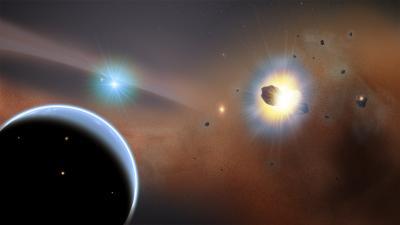Astronomers exploring the disk of debris around the young star Beta Pictoris have discovered a compact cloud of carbon monoxide located about 8 billion miles (13 billion kilometers) from the star. This concentration of poisonous gas – usually destroyed by starlight – is being constantly replenished by ongoing rapid-fire collisions among a swarm of icy, comet-like bodies.
In fact, to offset the destruction of carbon monoxide (CO) molecules around the star, a large comet must be getting completely destroyed every five minutes, say researchers.
They suggest the comet swarm is most likely frozen debris trapped and concentrated by the gravity of an as-yet-unseen exoplanet.
This mystery 'shepherd' exoplanet – so-called for its capacity to corral the swarms of comets through its gravitational pull, like Jupiter in our own solar system – is likely to be about the size of Saturn.
"Detailed dynamical studies are now under way, but at the moment we think this shepherding planet would be around Saturn's mass and positioned near the inner edge of the CO belt," said Mark Wyatt, from Cambridge's Institute of Astronomy, who proposed the shepherd model – currently the favoured hypothesis because it explains so many puzzling features of the Beta Pictoris disk.
"We think the Beta Pictoris comet swarms formed when the hypothetical planet migrated outward, sweeping icy bodies into resonant orbits."
Paradoxically, the presence of carbon monoxide – so harmful to humans on Earth – could indicate that the Beta Pictoris planetary system may eventually be a good habitat for life. If there is CO in the comets, then there is likely also water ice – meaning that the cometary bombardment this system's planets are probably undergoing could also be providing them with life-giving water.
The findings are published today in the journal Science Express.

At the outer fringes of the system, the gravitational influence of a hypothetical giant planet (bottom left) captures comets into a dense, massive swarm (right) where frequent collisions occur.
(Photo Credit: NASA's Goddard Space Flight Center/Francis Reddy)
The clump was discovered when an international team of astronomers, led by ALMA-based ESO astronomer Bill Dent, along with Wyatt, used the Atacama Large Millimeter/submillimeter Array (ALMA) in Chile to map the millimeter-wavelength light from dust and carbon monoxide molecules in the disk surrounding Beta Pictoris, a star located about 63 light-years away and only 20 million years old.
Beta Pictoris is considered one of the best examples of a typical young solar system, and hosts one of the closest and brightest debris disks known – making it an ideal laboratory for studying the early development of planetary systems. The latest findings could help us understand what conditions were like during the formation of our own solar system.
Much of the carbon monoxide is concentrated in a single clump located about 8 billion miles (13 billion kilometers) from the star, or nearly three times the distance between the planet Neptune and the sun. The total amount of the gas observed exceeds 200 million billion tons – equivalent to about one-sixth the mass of Earth's oceans, say researchers.
The presence of all this gas is a clue that something interesting is going on because ultraviolet starlight breaks up CO molecules in about 100 years, much faster than the main cloud can complete a single orbit around the star. "So unless we are observing Beta Pictoris at a very unusual time, then the carbon monoxide we observed must be continuously replenished," said Bill Dent, ESO astronomer based at ALMA and lead author on the paper.
The researchers calculate that a large comet must be completely destroyed every five minutes, and only an unusually massive and compact swarm of comets could support such an astonishingly high collision rate.
"Although toxic to us, carbon monoxide is one of many gases found in comets and other icy bodies," said team member Aki Roberge, an astrophysicist at NASA's Goddard Space Flight Center. "In the rough-and-tumble environment around a young star, these objects frequently collide and generate fragments that release dust, icy grains and stored gases."
Because we view the disk nearly edge-on, the ALMA data cannot determine whether the carbon monoxide belt has a single concentration of gas or two on opposite sides of the star. Further studies of the gas cloud's orbital motion will clarify the situation, but current evidence favors a two-clump scenario, which in turn points to a shepherding planet.
In our own solar system, Jupiter's gravity has trapped thousands of asteroids in two groups, one leading and one following it as it travels around the sun. A giant planet located in the outer reaches of the Beta Pictoris system likewise could corral comets into a pair of tight, massive swarms.
Astronomers have already directly imaged one giant exoplanet, Beta Pictoris b, with a mass several times greater than Jupiter, orbiting much closer to the star. While it would be unusual for a giant planet to form up to 10 times farther away, as required to shepherd the massive comet clouds, the hypothetical planet could have formed near the star and migrated outward as the young disk underwent changes. Indeed, this outward motion is needed to corral the comets.
If, however, the gas actually turns out to form a single clump, Wyatt's recently graduated Cambridge PhD student Alan Jackson, also a co-author on the paper, suggested an even more violent alternative scenario. A crash between two Mars-sized icy planets about half a million years ago would account for the comet swarm, with frequent ongoing collisions among the fragments gradually releasing carbon monoxide gas.
Either way, Beta Pictoris clearly has a fascinating story to tell, say the scientists, one that could provide insight into the early development of our own solar system.
Source: University of Cambridge